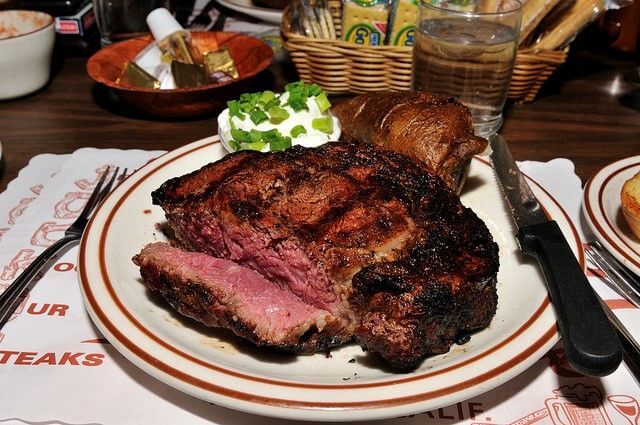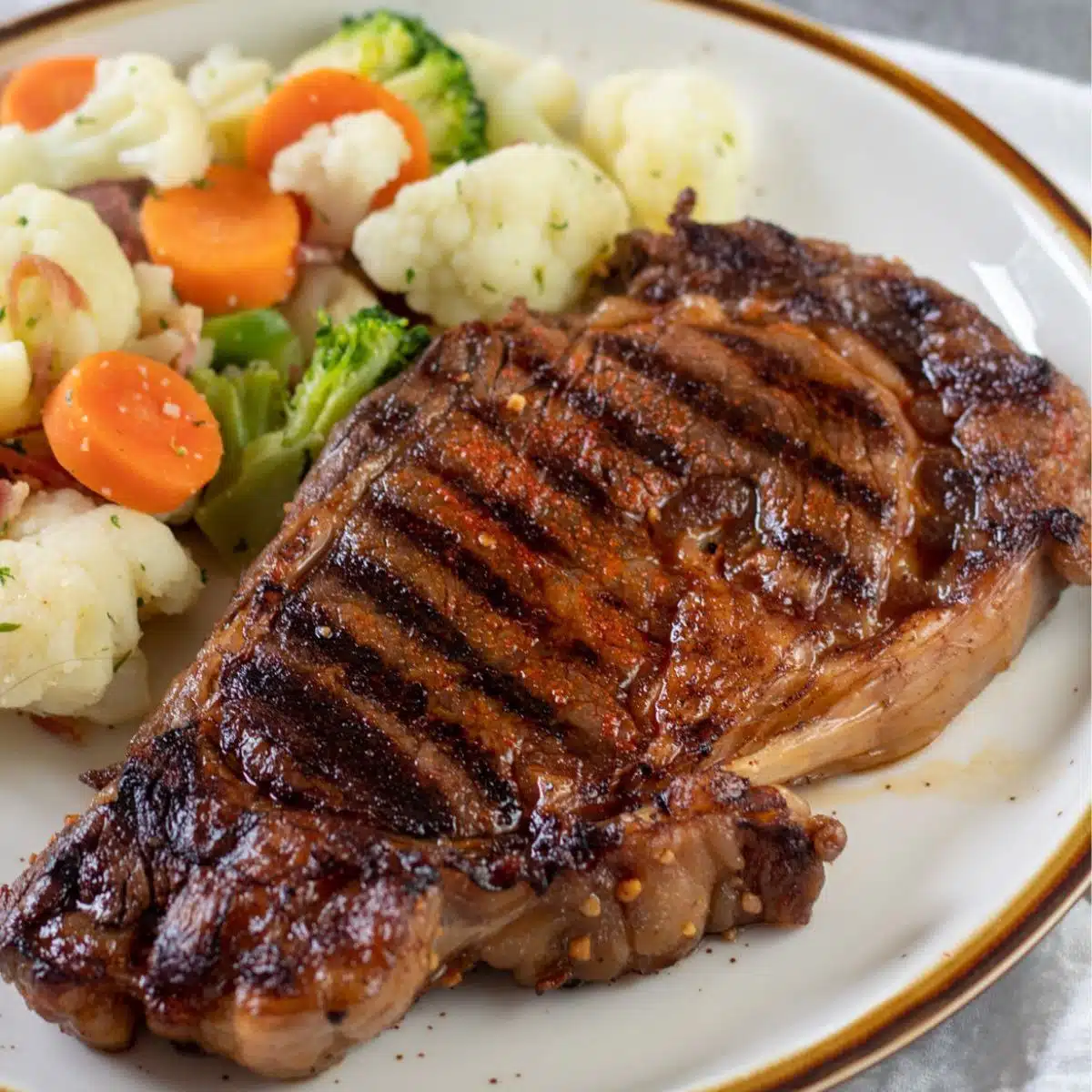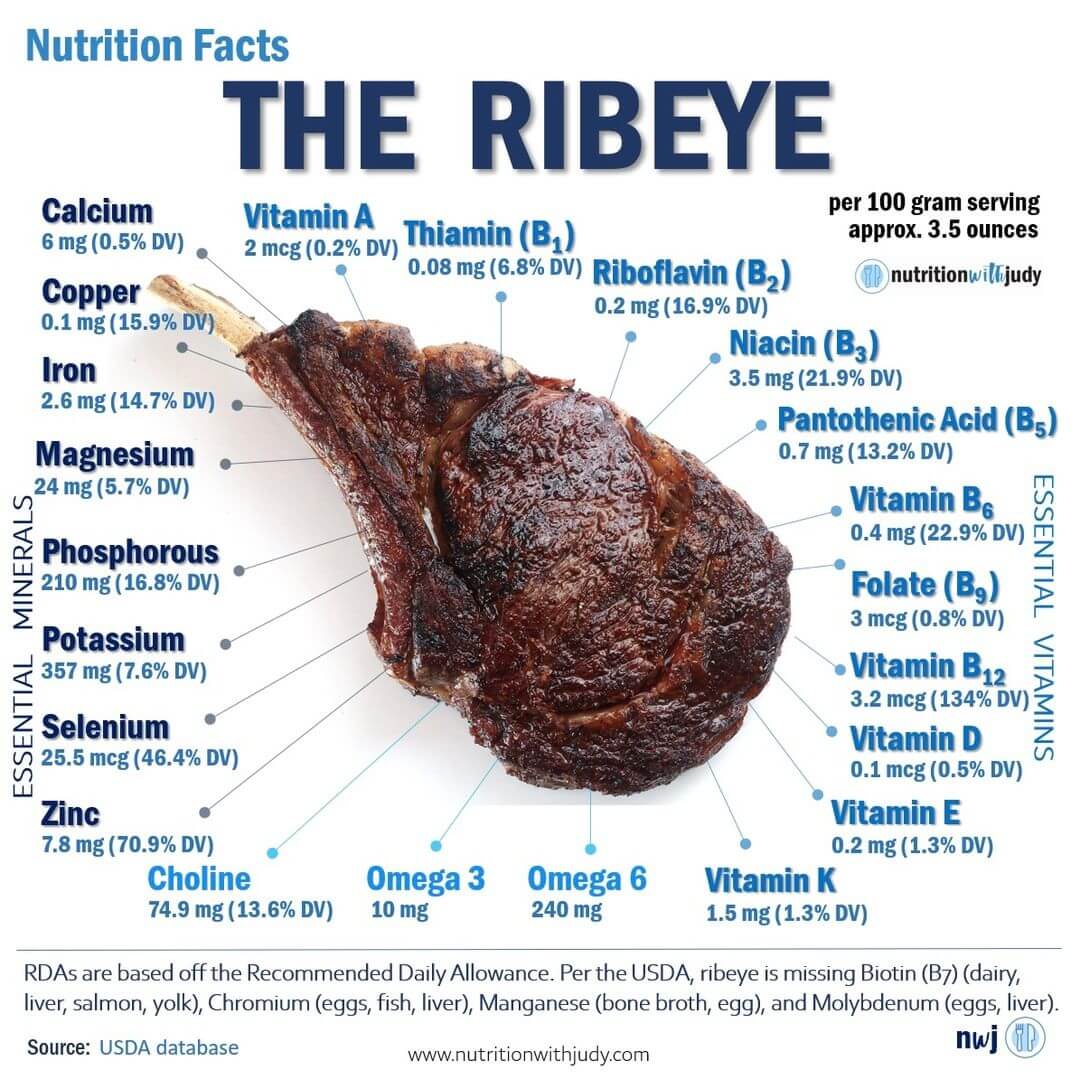
Ribeye Steak Nutrition Facts : A Complete Guide
Ribeye steak is a high-protein food, rich in vitamins and minerals, and low in carbohydrates and sodium. It is a popular choice among meat lovers due to its tender and juicy texture.
Now for a more detailed Ribeye steak is a delicious and flavorful cut of beef that is loved by many for its melt-in-your-mouth tenderness. It is a high-quality protein source, packed with essential amino acids that are vital for muscle growth and repair.
This juicy steak is also a good source of vitamins, including B vitamins like thiamin, riboflavin, niacin, and vitamin B12, which are necessary for energy production and a healthy nervous system. Additionally, ribeye steak is rich in essential minerals such as iron, zinc, and selenium, which play a crucial role in various bodily functions, including immune function and metabolism. In addition to its nutritional benefits, ribeye steak is a versatile ingredient that can be prepared in various cooking methods, making it a mouthwatering choice for any meal.
What Is Ribeye Steak?
Ribeye steak is a popular cut of beef known for its tenderness, juiciness, and intense flavor. This steak is taken from the rib section of a cow, specifically the rib primal. It is known by different names in various parts of the world, such as ribeye, rib eye, beauty steak, Delmonico steak, and Scotch fillet.
Description
Ribeye steak is renowned for its impressive marbling, which is the streaks of fat interlaced within the meat. This marbling contributes to its rich flavor and succulent texture. The high-fat content in ribeye steak makes it one of the most flavorful and tender cuts of beef available.
Nutritional Value
Let’s take a closer look at the nutritional value of ribeye steak:
| Nutrient | Amount per 100g |
|---|---|
| Protein | 26g |
| Fat | 20g |
| Calories | 275 |
| Iron | 2.6mg |
| Zinc | 5.1mg |
| Vitamin B12 | 2.9mcg |
Ribeye steak is a great source of protein, providing 26g per 100g serving. Protein is essential for the growth, repair, and maintenance of body tissues. It is also a significant source of fat, with 20g per 100g serving. This fat content contributes to the steak’s flavor and mouthfeel.
The calorie content of ribeye steak is around 275 calories per 100g serving. While higher in calories compared to leaner cuts of beef, ribeye steak offers a rich and satisfying dining experience. Additionally, ribeye steak contains important minerals such as iron, zinc, and vitamin B12, which are essential for maintaining a healthy body.

Credit: www.pinterest.com
Health Benefits Of Ribeye Steak
Ribeye steak is not only known for its delicious taste, but it also offers numerous health benefits. Packed with essential nutrients and minerals, ribeye steak can be a valuable addition to your diet when consumed in moderation. In this article, we will explore the health benefits of ribeye steak in detail, highlighting its protein content and its richness in vitamins and minerals.
Protein Content
One of the notable health benefits of ribeye steak is its high protein content. Protein plays a crucial role in the growth, repair, and maintenance of body tissues. A 3-ounce serving of ribeye steak provides approximately 26 grams of protein, making it an excellent choice for individuals looking to meet their daily protein requirements. This nutrient is especially important for athletes, bodybuilders, and those recovering from injuries.
Rich In Vitamins And Minerals
Ribeye steak is not only a great source of protein, but it also packs a punch when it comes to vitamins and minerals. Here are some of the key nutrients found in ribeye steak:
- Vitamin B12: Ribeye steak is rich in vitamin B12, which is essential for the formation of red blood cells and the maintenance of a healthy nervous system.
- Zinc: This nutrient found in ribeye steak contributes to the normal functioning of the immune system and supports wound healing.
- Selenium: Ribeye steak is a good source of selenium, an antioxidant that helps protect cells from damage and supports thyroid function.
- Iron: Iron, found in ribeye steak, is vital for the production of hemoglobin, which carries oxygen to various parts of the body.
- Phosphorus: Ribeye steak contains phosphorus, which is important for the formation and maintenance of healthy bones and teeth.
By incorporating ribeye steak into your diet, you can easily boost your intake of these essential vitamins and minerals, promoting overall health and well-being.
Overall, ribeye steak offers several health benefits, including its high protein content and abundance of vitamins and minerals. However, it is important to consume ribeye steak in moderation as part of a well-balanced diet, as excessive intake of red meat can have negative health effects. Now that you are aware of the health benefits, you can enjoy a delicious ribeye steak knowing that it is not only tasty but also beneficial for your body.
Concerns And Considerations
Ribeye steak is a nutritious food choice, but it’s important to be aware of certain concerns and considerations, particularly related to its high saturated fat content and the potential for overconsumption.
High In Saturated Fat
Saturated fat: can increase LDL cholesterol levels, which may lead to heart disease.
- Ribeye steak is known to contain significant amounts of saturated fat.
- Consuming too much saturated fat can negatively impact heart health.
Potential For Overconsumption
Overconsumption: may contribute to weight gain and increase the risk of chronic diseases.
- Eating large portions of ribeye steak regularly may lead to overconsumption of calories.
- Balancing ribeye steak consumption with leaner protein sources is advised to prevent overconsumption.
Comparing Ribeye Steak With Other Cuts
When considering the nutritional value of ribeye steak, it’s insightful to compare it with other popular cuts of beef. This allows for a better understanding of its calorie content, fat levels, and nutrient variations.
Calorie And Fat Comparison
Ribeye steak is known for its rich, succulent flavor, but it also comes with a higher calorie and fat content compared to certain other beef cuts. Let’s take a look at a quick comparison:
| Beef Cut | Calories (per 3 oz) | Total Fat (per 3 oz) |
|---|---|---|
| Ribeye Steak | 229 | 16g |
| Sirloin Steak | 190 | 10g |
| Tenderloin Steak | 150 | 8g |
As demonstrated in the comparison, ribeye steak contains higher calories and fat than some other popular cuts. Therefore, individuals with specific dietary requirements should be mindful when incorporating it into their meals.
Nutrient Variations
While ribeye steak is often praised for its robust flavor, it’s essential to acknowledge the nutrient variations compared to alternative cuts. Here’s a brief overview:
- Protein: Ribeye steak tends to have slightly lower protein levels compared to leaner cuts like tenderloin or sirloin steak.
- Vitamins and Minerals: Ribeye is a good source of vitamins B6 and B12, essential for energy metabolism, but may have lower levels of certain nutrients like iron when compared to other cuts.
- Marbling: The marbling in ribeye steak contributes to its rich flavor, but it also affects its nutritional profile by increasing its fat content and calorie density.
Considering these factors, it’s important for consumers to evaluate their nutritional needs and preferences when choosing between different cuts of beef.
Preparation Tips For A Healthier Option
Ribeye steak is a delicious and flavorful cut of meat that can be part of a healthy diet when prepared with the right techniques. By following some preparation tips for a healthier option, you can enjoy a mouthwatering ribeye steak while maintaining your nutrition goals.
Grilling And Seasoning Suggestions
When it comes to preparing a ribeye steak for a healthier option, grilling is an ideal cooking method. It allows excess fat to drip away, resulting in a leaner dish.
- Season the steak with a simple mix of olive oil, garlic, and herbs to enhance the flavor without adding unnecessary calories or sodium.
- Opt for lower-sodium seasoning blends or create your homemade seasoning to avoid excessive sodium intake.
- Avoid butter or heavy sauces – instead, serve the steak with a squeeze of fresh lemon juice
Pairing With Healthy Sides
In addition to the preparation of the steak itself, the choice of sides can contribute to a healthier overall meal. When pairing ribeye steak with sides, consider incorporating nutritious options to balance the dish.
- Include a variety of colorful vegetables such as roasted asparagus, grilled zucchini, or a mixed green salad to add fiber and essential nutrients to the meal.
- Opt for whole grains like quinoa, brown rice, or sweet potatoes for a source of complex carbohydrates and additional fiber.
- Choose lighter alternatives for dressing or sauces, such as a drizzle of balsamic vinaigrette or a dollop of Greek yogurt-based sauce.

Credit: bakeitwithlove.com
Incorporating Ribeye Steak Into Different Diets
Ribeye steak is a flavorful and nutrient-dense food that can be a versatile addition to various dietary plans. Let’s explore how you can include ribeye steak in different diets such as Keto and Paleo.
Keto Diet
Ribeye steak is an ideal choice for those following a Keto diet, which focuses on low-carb and high-fat intake. This cut of beef is rich in protein and healthy fats, making it a perfect option for Keto enthusiasts.
- High protein content supports muscle growth and repair.
- Healthy fats in ribeye steak promote satiety and help with ketosis.
- Zero carbs in ribeye steak make it a Keto-friendly food choice.
Paleo Diet
For individuals adhering to a Paleo diet, which emphasizes whole, unprocessed foods, ribeye steak is a great fit. This primal cut aligns well with the Paleo principles of consuming nutrient-dense foods.
- Ribeye steak is rich in iron, supporting overall health and energy levels.
- It provides essential vitamins such as B12 and B6 for optimal body function.
- The natural fatty acids in ribeye steak promote heart health.
By incorporating ribeye steak into your Keto or Paleo diet, you can enjoy a delicious and nutritious meal that supports your health and wellness goals.
Tips For Buying The Best Ribeye Steak
When it comes to buying the best ribeye steak, there are a few key factors to consider that can greatly enhance your dining experience. From understanding the difference between grass-fed and grain-fed beef to identifying the perfect marbling and thickness, making informed choices will ensure you savor the juiciest and most tender steak possible.
Grass-fed Vs. Grain-fed
One of the first decisions you’ll need to make when purchasing a ribeye steak is whether to opt for grass-fed or grain-fed beef. Grass-fed beef comes from cattle that have primarily grazed on pasture, while grain-fed beef comes from cattle that have been fed a diet of grains like corn and soybeans.
While both options can result in delicious steaks, there are a few notable differences to consider. Grass-fed beef tends to have a leaner and slightly gamier flavor, while grain-fed beef typically boasts a more buttery and rich taste. Additionally, grass-fed beef is often more nutrient-dense, containing higher levels of omega-3 fatty acids and vitamins.
Marbling And Thickness
When selecting a ribeye steak, you’ll want to pay close attention to the marbling and thickness of the cut. Marbling refers to the distribution of fat throughout the muscle of the steak, and it is a key indicator of tenderness, juiciness, and flavor.
Look for ribeye steaks with abundant marbling, as this fat will melt during cooking, imparting moisture and flavor to the meat. Aim for steaks with a generous amount of visible white lines of fat throughout the muscle for the best eating experience.
The thickness of the ribeye steak is also crucial, as it determines the cooking time and overall mouthfeel. Thicker steaks tend to be more forgiving and allow for a more evenly cooked piece of meat. Aim for a thickness of at least one inch to achieve a juicy and tender ribeye steak.

Credit: www.nutritionwithjudy.com
What Are the Nutritional Benefits of Cooking Ribeye Steak in a Pan?
When you cook ribeye steak in a pan, the high heat helps to caramelize the outer layer, creating a delicious crust while locking in the juices. This cooking method also preserves the natural flavors and nutrients, making it a great option for a nutrient-rich and flavorful meal. Try this cook ribeye steak pan recipe for a satisfying and nutritious dish.
Frequently Asked Questions For Ribeye Steak Nutrition Facts
What Are The Nutritional Benefits Of Ribeye Steak?
Ribeye steak is a great source of protein and essential nutrients like iron, zinc, and B vitamins. It also provides healthy fats and can support muscle growth and overall health.
How Does Ribeye Steak Contribute To A Balanced Diet?
Ribeye steak offers a balance of protein, fats, and essential nutrients. When consumed in moderation, it can be part of a well-rounded diet, providing important nutrients for overall health and wellness.
Are There Any Health Considerations For Consuming Ribeye Steak?
While ribeye steak offers valuable nutrients, it’s important to moderate consumption due to its high saturated fat content. Choosing lean cuts and balancing with other foods can help maintain a healthy diet.
Can Ribeye Steak Be Part Of A Weight Management Plan?
In moderation, ribeye steak can be included in a balanced weight management plan. Its high protein content can promote satiety, which may support weight loss or maintenance goals when part of a thoughtful diet.
Conclusion
Incorporating ribeye steak into your diet can be a nutritious and delicious choice. Its high protein content and essential nutrients make it a valuable addition to your meals. Embrace the benefits of ribeye steak for a flavorful way to support your overall health and wellbeing.

